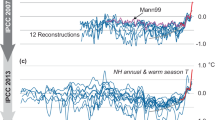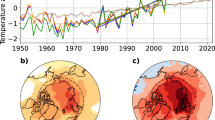Abstract
Reconstructions of climate from marine sediment1 and ice2 cores show that the amplitude of glacial–interglacial climate cycles increased substantially after the Mid-Brunhes Event3, about 430,000 years ago. Interglacial periods before the event seem to be characterized by larger continental ice sheets, lower sea level4,5, cooler temperatures in Antarctica2 and lower atmospheric CO2 concentrations6, relative to the more recent interglacials. Here we use an Earth system model of intermediate complexity to assess the contributions of insolation and greenhouse-gas concentrations to the climate associated with the peaks of all the interglacials over the past 800,000 years. Our simulations recreate the expected warmer interglacials after the Mid-Brunhes Event and suggest that later interglacials are warmer primarily because of increased global mean temperatures during Northern Hemisphere winters. This warmth arises from increased insolation during this season, relative to the interglacials that preceded the Mid-Brunhes Event, in conjunction with increased atmospheric greenhouse-gas concentrations. The effect of boreal winters and of the Southern Hemisphere, which is also warmer during austral winters, on the carbon cyle should be assessed when investigating the underlying causes of the higher CO2 concentrations during the later interglacials.
This is a preview of subscription content, access via your institution
Access options
Subscribe to this journal
Receive 12 print issues and online access
$259.00 per year
only $21.58 per issue
Buy this article
- Purchase on Springer Link
- Instant access to full article PDF
Prices may be subject to local taxes which are calculated during checkout



Similar content being viewed by others
References
Lisiecki, L. E. & Raymo, M. E. A Pliocene–Pleistocene stack of 57 globally distributed benthic delta 18O records. Paleoceanography 20, PA1003 (2005).
EPICA community members. Eight glacial cycles from an Antarctic ice core. Nature 429, 623–628 (2004).
Jansen, J. H. F., Kuijpers, A. & Troelstra, S. R. A Mid-Brunhes climatic event: Longterm changes in global atmosphere and ocean circulation. Science 232, 619–622 (1986).
Lambeck, K., Esat, T. M. & Potter, E. K. Links between climate and sea levels for the past three million years. Nature 419, 199–206 (2002).
Bintanja, R., van de Wal, R. S. W. & Oerlemans, J. Modelled atmospheric temperatures and global sea level over the past million years. Nature 437, 125–128 (2005).
Lüthi, D. et al. High-resolution carbon dioxide concentration record 650,000–800,000 years before present. Nature 453, 379–382 (2008).
Ganopolski, A., Kubatzki, C., Claussen, M., Brovkin, V. & Petoukhov, V. The influence of vegetation–atmosphere–ocean interaction on climate during the mid-Holocene. Science 280, 1916–1919 (1998).
Crucifix, M. & Loutre, M. F. Transient simulations over the last interglacial period (126–115 kyr BP): Feedback and forcing analysis. Clim. Dynam. 19, 417–433 (2002).
Loutre, M. F., Berger, A., Crucifix, M., Desprat, S. & Sanchez-Goñi, M. F. in The Climate of Past Interglacials, Developments in Quaternary Science (eds Sirocko, F., Claussen, M., Sanchez-Goñi, M. F. & Litt, T.) 547–561 (Elsevier, 2007).
Kubatzki, C., Claussen, M., Calov, R. & Ganopolski, A. in The Climate of Past Interglacials, Developments in Quaternary Science (eds Sirocko, F., Claussen, M., Sanchez-Goñi, M. F. & Litt, T.) 583–593 (Elsevier, 2007).
Driesschaert, E. et al. Modeling the influence of Greenland ice sheet melting on the Atlantic meridional overturning circulation during the next millennia. Geophys. Res. Lett. 34, L10707 (2007).
Opsteegh, J. D., Haarsma, R. J., Selten, F. M. & Kattenberg, A. ECBILT: A dynamic alternative to mixed boundary conditions in ocean models. Tellus 50, 348–367 (1998).
Goosse, H. & Fichefet, T. Importance of ice-ocean interactions for the global ocean circulation: A model study. J. Geophys. Res. 104, 23337–23355 (1999).
Brovkin, V., Ganapolski, A. & Svirezhev, Y. A continuous climate-vegetation classification for use in climate-biosphere studies. Ecol. Model. 101, 251–261 (1997).
Milankovitch, M. M. Kanon der Erdbestrahlung und seine Anwendung auf des Eizeitenproblem R. Serbian Acad. Spec. Publ. Vol 132, Sect. Math. Nat. Sci., 633 (1941) (Canon of Insolation and the ice-age problem, English translation by Israel Program for Scientific Translation, Jerusalem, 1969).
Loulergue, L. et al. Orbital and millennial-scale features of atmospheric CH4 over the past 800,000 years. Nature 453, 383–386 (2008).
Spahni, R. et al. Atmospheric methane and nitrous oxide of the late pleistocene from Antarctic ice cores. Science 310, 1317–1321 (2005).
Berger, A., Loutre, M. F. & Tricot, Ch. Insolation and Earth’s orbital periods. J. Geophys. Res. 98, 10341–10362 (1993).
Jouzel, J. et al. Orbital and millennial Antarctic climate variability over the past 800,000 years. Science 317, 793–796 (2007).
Yin, Q. Z., Berger, A. & Crucifix, M. Individual and combined effects of ice sheets and precession on MIS-13 climate. Clim. Past 5, 229–243 (2009).
Claussen, M. Late quaternary vegetation-climate feedbacks. Clim. Past 5, 203–216 (2009).
Stein, U. & Alpert, P. Factor separation in numerical simulations. J. Atmos. Sci. 50, 2107–2115 (1993).
Berger, A. Long-term variations of daily insolation and quaternary climatic changes. J. Atmos. Sci. 35, 2362–2367 (1978).
Imbrie, J. et al. in Milankovitch and Climate, Part 1 (eds Berger, A. L. et al.) 269–305 (D. Reidel Pub., 1984).
Acknowledgements
This work is supported by the European Research Council Advanced Grant EMIS (No 227348 of the Programme ‘Ideas’). Q.Z.Y. is a postdoctoral fellow of the Belgian National Fund for Scientific Research (F.R.S.-FNRS) and has benefited from personal support by Y. du Monceau. Access to computer facilities was made easier through sponsorship from S. A. Electrabel, Belgium.
Author information
Authors and Affiliations
Contributions
Both authors contributed equally to the design of the experiments, the analysis of the results and the writing of the paper. Q.Z.Y. carried out the modelling experiments.
Corresponding author
Ethics declarations
Competing interests
The authors declare no competing financial interests.
Supplementary information
Supplementary Information
Supplementary Information (PDF 355 kb)
Rights and permissions
About this article
Cite this article
Yin, Q., Berger, A. Insolation and CO2 contribution to the interglacial climate before and after the Mid-Brunhes Event. Nature Geosci 3, 243–246 (2010). https://doi.org/10.1038/ngeo771
Received:
Accepted:
Published:
Issue Date:
DOI: https://doi.org/10.1038/ngeo771
This article is cited by
-
Distinctive changes of Asian–African summer monsoon in interglacial epochs and global warming scenario
Climate Dynamics (2023)
-
Long-chain alkenones in the Shimosa Group reveal palaeotemperatures of the Pleistocene interglacial Palaeo-Tokyo Bays
Progress in Earth and Planetary Science (2022)
-
Comparison of Arctic and Southern Ocean sea ice between the last nine interglacials and the future
Climate Dynamics (2022)
-
Paleoceanographic history of the Japan Sea over the last 9.5 million years inferred from radiolarian assemblages (IODP Expedition 346 Sites U1425 and U1430)
Progress in Earth and Planetary Science (2018)
-
Unraveling the forcings controlling the vegetation and climate of the best orbital analogues for the present interglacial in SW Europe
Climate Dynamics (2018)




